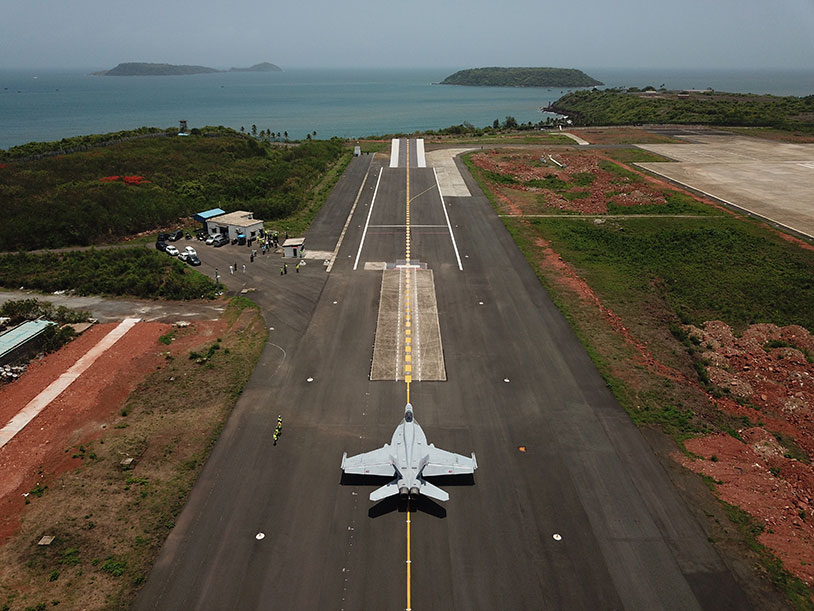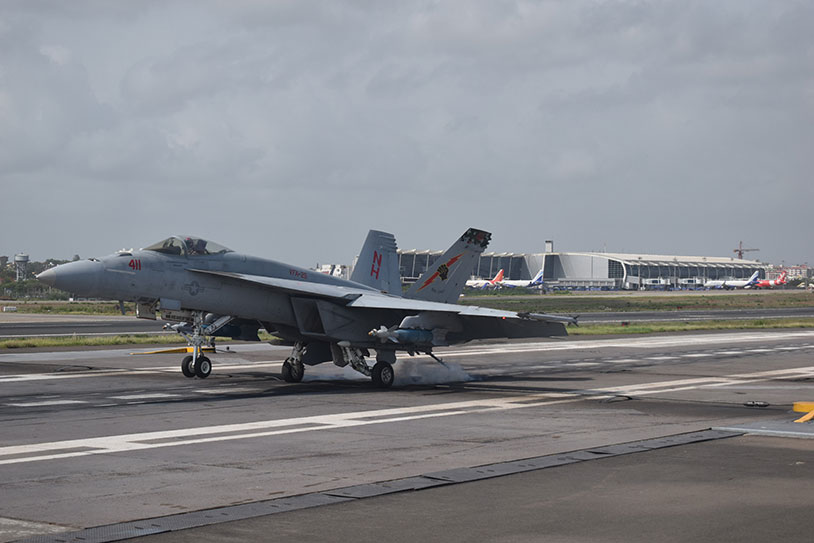Boeing F/A-18 Super Hornet Successfully Completes Operational Demonstrations in India
- Completed multiple ski-jumps, roll-in and fly-in arrestments, as well as performance flights in a variety of weights and configurations
- F/A-18 Demonstrates Carrier Compatibility to Indian Navy requirements
Goa, India, July 20, 2022 - Boeing’s F/A-18 Super Hornet successfully completed operational demonstration tests at Indian Naval Station Hansa in Goa, India, and reinforced the Super Hornet’s ability to effectively and safely operate off Indian Navy carriers.
Two U.S. Navy F/A-18E Super Hornets completed multiple ski-jumps, roll-in and fly-in arrestments, as well as performance flights, in a variety of weights in the air-to-air, air-to-ground, and air-to-surface configurations, meeting the Indian Navy test requirements.
 Photo Credit: Indian Navy
Photo Credit: Indian Navy
“The Boeing team was privileged to showcase the F/A-18 Super Hornet’s compatibility with Indian carriers in Goa,” said Alain Garcia, vice president, India business development Boeing Defense, Space & Security and Global Services. “As the premier frontline multi-role naval fighter, the F/A-18 Super Hornet is one of the world’s most proven and affordable multi-role fighters and continues to evolve with the development of the next-generation Block III capability which will be game-changing for India.”
“With the Super Hornet Block III, the Indian Navy would not only get the most advanced platform but would also benefit from tactics, upgrades and knowledge related to the naval aviation ecosystem that the U.S. Navy offers,” he added.
The tests followed eight ski-jumps in various weights and configurations during previous tests held at Naval Air Station (NAS) Patuxent River in Maryland in late 2020 that demonstrated the Super Hornet’s ability to operate from a short takeoff but arrested recovery (STOBAR) aircraft carrier.
 Photo Credit: Indian Navy
Photo Credit: Indian Navy
F/A-18 Super Hornet India Factsheet:
- As the U.S. Navy’s frontline fighter, with over 800 aircraft delivered around the world and over 2.5 million flight hours flown, the Super Hornet Block III offers opportunities for cooperation and interoperability between the United States and India navies
- The Super Hornet Block III will come with advanced networking and open architecture design that will allow Super Hornet to be interoperable with the Indian Navy’s P-8I and other US-origin assets and rapidly accept new technology to stay ahead of emerging threats.
- Boeing and the U.S. Navy made multi-billion-dollar investments in infusing new technologies in the Super Hornet Block III, including increasing the life of the airframe to 10,000 hours from 6,000 hours of Block II, radar cross-section improvements, and advanced crew station which includes a large area display.
- The F/A-18 Super Hornet has been designed and built for carrier operations, and is fully compliantwith INS Vikramaditya and INS Vikrant aircraft carriers. F/A-18 will be able to operate on the deck, in the hangar and on the lifts of the Indian Navy’s aircraft carriers.
- The F/A-18 can carry four anti-ship missiles (Harpoon).
- The two-seater carrier compatible variant of the Super Hornet offers several unique advantages to the Indian Navy including flexibility, higher utilization of the fleet, and the ability to embark on certain missions from the carrier that benefit from having a second crew member. Additionally, two-seater F/A-18 Super Hornets can be used as trainers (ashore and on the carrier) and as fully capable fighters, operational from the carrier and from land bases.
- Designed as a carrier-based fighter for high- loading, high stress operations, the F/A-18E/F Super Hornet Block III requires minimal support equipment and has the lowest cost per flight hour to operate with high mission readiness rates.
- Depending on the Indian Navy’s requirements, Boeing’s “By India–For India Sustainment Program” that is built on other successful sustainment programs that Boeing is executing for the Indian Air Force and the Indian Navy today will allow for capabilities development in India to sustain the F/A-18 Super Hornet.
- Powered by the GE F-414 engine that has clocked more than 5 million hours, the F/A-18 Super Hornet Block III uses the same family of engines that is powering India’s indigenous Light Combat Aircraft (LCA); that has already been inducted by the Indian Air Force. The commonality in engines will create scale efficiencies for potential sustainment opportunities in the future.
About Boeing in India
Boeing’s advanced aircraft and services focus plays an important role in mission-readiness for the Indian Air Force and Indian Navy. Boeing has strengthened its supply chain with more than 280 local companies in India and a joint venture to manufacture fuselages for Apache helicopters. Annual sourcing from India stands at $1 billion. Boeing currently employs close to 4,000 people in India, and more than 7,000 people work with its supply chain partners. Boeing serves communities and citizenship programs to inspire change and make an impact on more than 500,000 lives in India.
Contacts
Siddhant Chauhan
Boeing India communications
+91 9818781144
siddhant.chauhan@boeing.com
Michael Irvine
F/A-18 Program Communications
+1 (314) 2811168
michael.k.irvine@boeing.com
Sami Al Otaibi
International Business Development Communications
+1 (571) 5278490
Sami.s.alotaibi@boeing.com
